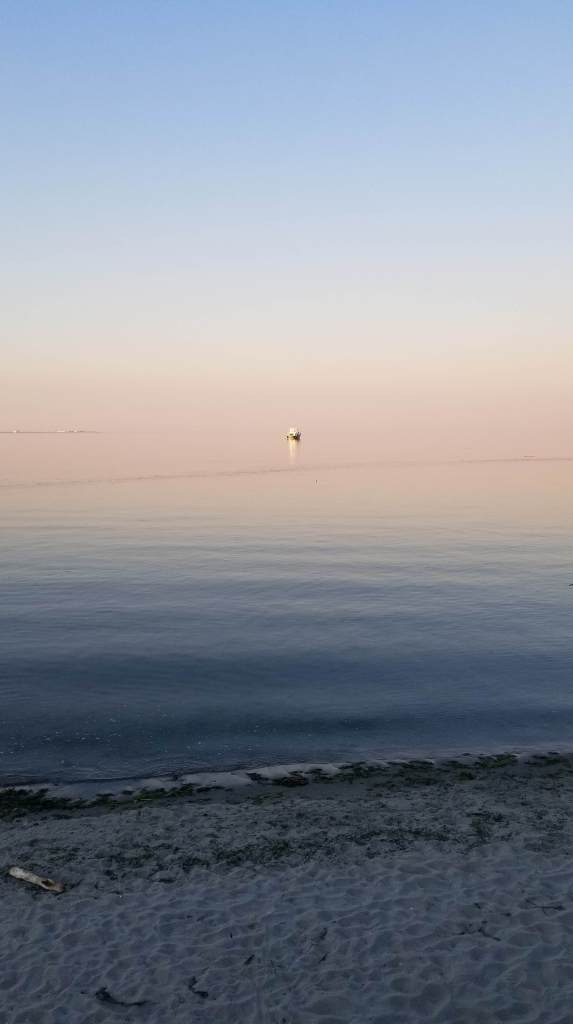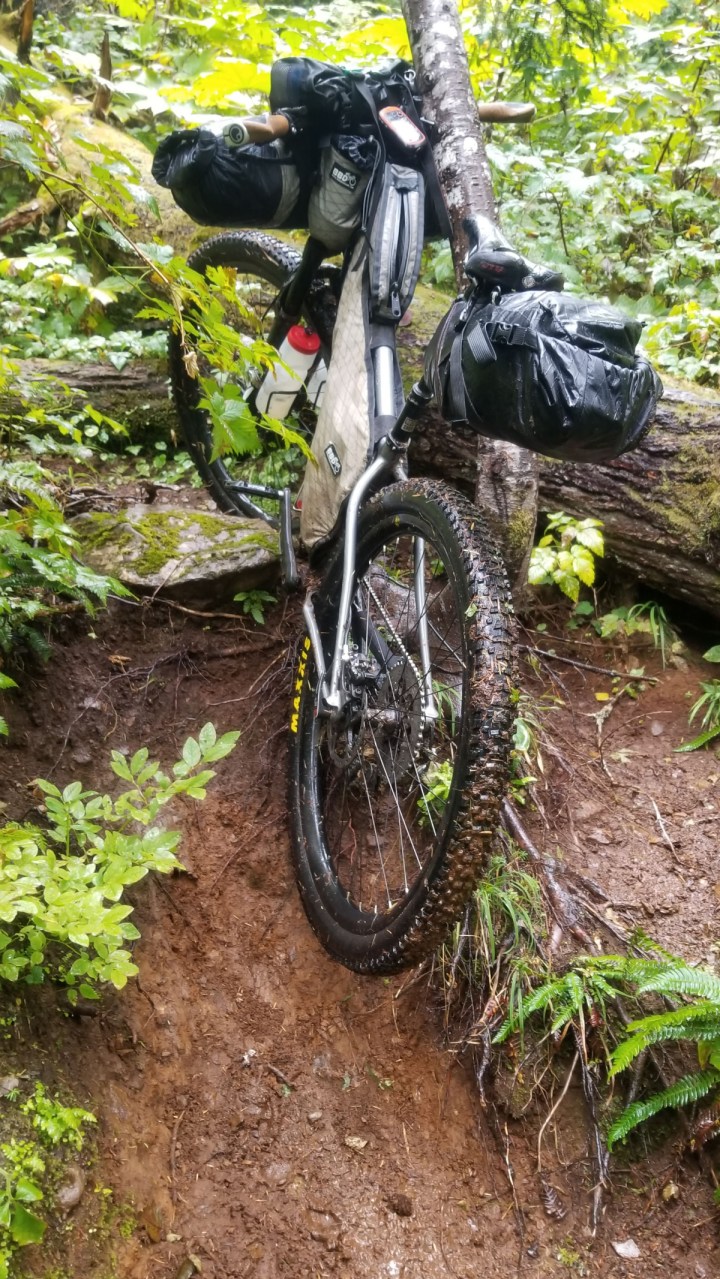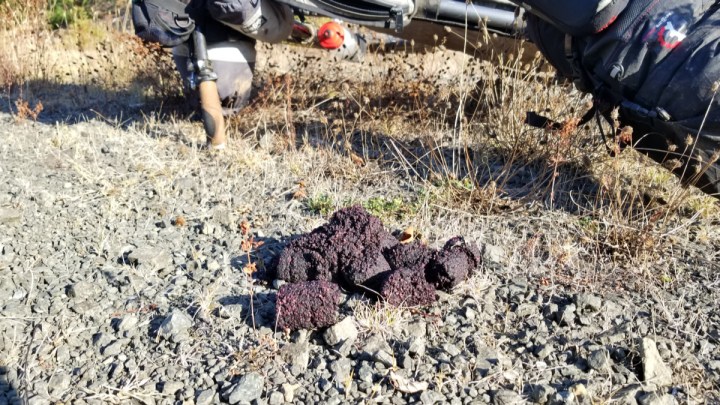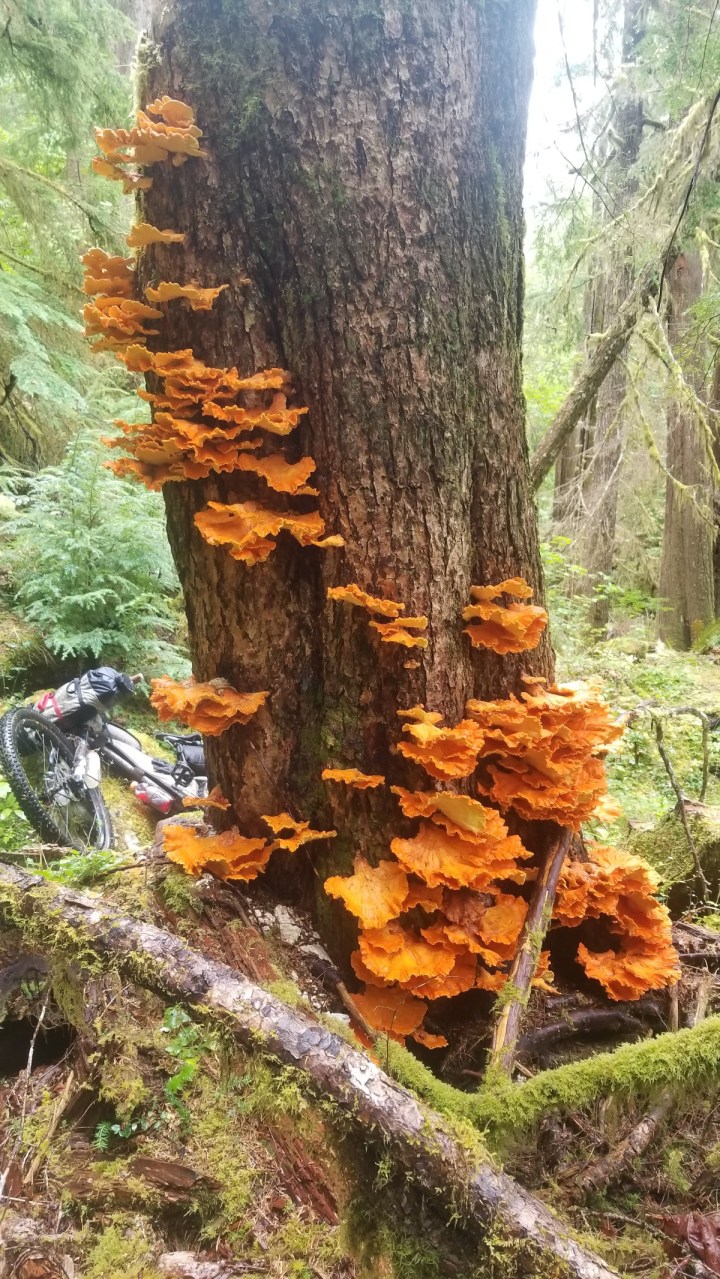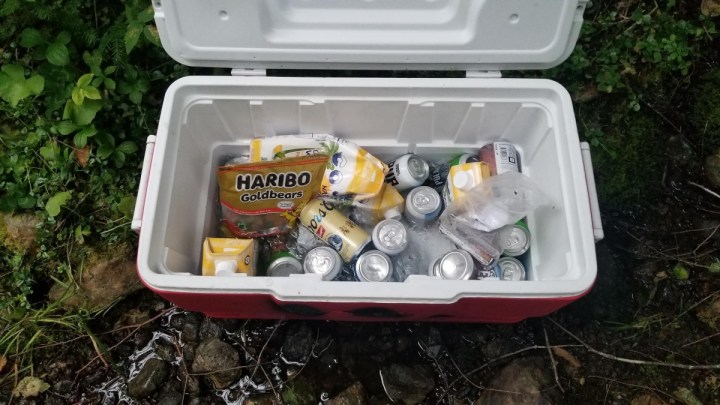In this blog post, nerdy as usual, I’m going to share some gear pics and notes and some thoughts on “racing” the “Buck Wild” portion of the Olympic 420 mountain bike race.
To get an official Buck Wild you have to get from Port Angeles to Quilcene in under 24hrs. Last year it took me two full days. The route is no joke. I didn’t see how it was possible last year when it took me two days. You leave with the other racers all at the same time except Quilcene is your end goal. Strava data from a racer showed nearly 14,000′ of elevation gain and 100 miles. That’s like a normal person’s month or more of mountain biking. http://www.olympic420.com/route/buck-wild
This year started off rather unusual as expected of anything happening in 2020. The plan was originally to race the XWA-Cross Washington again this year but Covid19 put a damper on the overall vibe of cross state racing for me, and many others I assume. So I switched to the thought of taking a shot at the Olympic 420 again. I spent many months torturing myself on ridiculous local rides here in the Teanaway area of Central Washington, my new home. Lots of pushing uphill on impossible moto trails in order to rip as fast as possible down them. As the date came closer and closer it seemed that Covid19 was still a big issue, route closures on the route, construction and then continuous huge forest fires really threw a wrench in the spokes. We now have a pandemic, major re-routes around iconic parts of the route, terrible air quality from massive wildfires around the west to deal with. Even with all that I think the race saw it’s largest gathering of racers (17 lined up, two were not on Trackleaders). This year also saw the event’s first female bad ass. Amy showed up and gave it hell for a bit on day 1.
The morning of the race we were all to gathering at the “Rocktopus” out near Hollywood Beach. The wildfire smoke appeared to be lifting a bit and a warm beautiful sunrise was working it’s way through the smoke and chaos. Then as we’re pulling up to the start it looks like something was wrong. I hear from Ron that a fellow racer’s bike was stolen while he was in doing some quick shopping at the Safeway there in town. Keep in mind it’s six something am. Lots of confusion as for what to do and everyone was gutted for this guy. His posse immediately headed out to try and help him recover his bike. I did a few laps around the area since there was nothing else I could do. With not knowing all the details as of writing this blog I do know that the bike was recovered pretty quickly, people found that out and word was spread by his buddies. A lot of relieved people then slowly started to head out on the trail, relieved and feeling good about leaving. So now it’s Pandemic, re-routes, closures, smoke and junkies haha. Good lord.
We left around 7:15 or so. Some before and some after but the start was certainly all messed up for most people. We were all just relieved to hear the bike was back in his possession, mostly all in tact enough to roll out. The sunrise along Strait of Juan De Fuca is amazing.
I was pretty good about not stopping and taking a ton of pictures the rest of the day. I’m glad for that because I ended up loosing my phone after it bounced out of my top tube bag while it was in there charging. It’s definitely on the “Sleepy Hollow” trail, most likely off to the side of one the various deep rough whoop-de-doos. So if anyone reading this happens across its please let me know.
For the Buck Wild there really isn’t any major details you need to know but here’s some details about the route. It starts with a long pavement/gravel approach to the mountains. *BTW this year they switched up the approach and it’s much better. There is a safer way across the crazy construction filled highway from town with endless cars and quicker way to gravel. That was a pleasant surprise. Then the route works its way up through various gravel back roads and some fun old horse/4×4/moto type dirt trails up to the first single track. But not after a long and kinda steep-ish slog up gravel roads and down then up and up again. I think it was at this point that people were realizing how they felt on their bikes. You drop off the FS rd at 3-Oclock Ridge onto the second half of the Lower Dungeness Tr. This is a really pretty trail. I got nailed by a bee that stuck in my helmet here and man did that smart for hours. Might be a good idea to bring a few Benadryl if you swell up from stings. From there you climb up and out to the Gold Creek Tr. This is by far my favorite trail out there. Super buff and so green and awesome flow. Next up, you connect to the Sleepy Hollow Tr where that takes you up to the base of Mt. Zion. Sleepy Hollow seems to be the place a lot of people camp on day 1 since there is water and good camp spots….but if you can muster up and over Zion at night you earn my respect and you can camp all along FS28/27 etc with plenty of water 😉 Upon our arrival there we were greeted by the generous hospitality of our friend Seth who set up an aid station for all the racers….so it was fair and even support we all got to enjoy. I slammed three beers and ate two burgers haha. Thanks Seth. Comparing times to last year I noticed I was at my camp spot from last year over 3 hours earlier. This felt good as it was a nice mental boost knowing I could do some of Zion in daylight but after a nice pit stop and loosing my phone and backtracking it just wasn’t enough. That’s OK.

Paul trying to fix his helmet strap. Not sure why I’m looking so concerned lol *Photo by Cam Chowdah
Once I got up to the summit of Mt. Zion I got right on the trail off the backside called Snow Creek. But a few hundred yards in I was cliffed out on this big rock outcrop. I could not find the trail. I looked and looked and because I had the 10K version of the GPX track on my old Garmin Etrex GPS it basically just showed this long straight line so there was no definition. I looked down this super nasty steep scree field off those rocks and scratched my head…..so I went for it….and that was a terrible idea. Realizing I was not on track I scrambled back up which was an effort all in it’s own with the steep rubble that collapsed under you and screaming leg/muscle cramps. I looked again for the trail and no dice. So I went back up to the top of Zion and messaged my wife saying I was stuck with what to do next. Normally I would’ve had cell reception here but the whole no phone thing screwed up the fact that I had the full resolution track for the race on Gaia as my backup and that would’ve helped. A few Inreach Satellite messages to my wife (you know the one who’s got a level head on at this moment) and she says the trail is there. Go find it,dude. Or something like that. I went back down and found it. Realizing I missed it due to looking more up than down…..the trail was narrow and easy to miss especially in the dark if you didn’t know it was there. And I DID know this because I’ve ridden it before but after 75 miles I was pretty whooped. I knew at that point I was on to finish no matter how long it took. I dropped down that trail, which is amazing btw (steep and spicy) to the trail out the back side that leads you back to FS28, called Deadfall. This trail is a bit of a punch in the gut. You think you’re sailing out and down and then you have to climb back up….a fair amount too. But knowing this you can enjoy the rest of the DH if gives you at the end. You just need to know that’s coming and just hike it out.
It was coming off this trail at nearly 1am or so that I saw my first camper and another hidden camper out behind them come to find out later and a few others beyond that up the FS roads. I loaded up on water and felt pretty energized knowing I was passing someone up. Now to be fair, they crushed the day ahead of me and were continuing on the next day so it wasn’t a fair comparison but I still got a lift out of seeing someone camped out. From here it’s actually a really pleasant climb up FSR 27 and the stars and planets were in full clear view. Until you get to the turnoff for the Lower Big Quilcene Tr. It’s kinda comical because here you think you’re home free but yet it’s more climbing. Dropping down the Lower Big Q trail would normally be amazing but it’s full of little climbs and things river trails like to do. Not a big deal unless you are suffering from massive chaffing in all the bad chaffy areas. Use your imagination. Not pleasant I’ll tell ya. Use your cremes and lubes people or stay dry like some people say….yeah good luck with that when it’s 80 degrees and you are a sweater. Use them a lot and take a mid race wash to get the salt off your areas. Trust me on this one. I stupidly pushed through the pain and discomfort knowing I was in the home stretch but it was so hard to even walk at that point. My wife will attest to what I looked like. Lube and clean often or you end up in the “pain cave” and no-one needs that totally preventable BS. I don’t mean to take the Lower Big Q’s glory away with my chaffing issues but man was it miserable. It’s a great trail (the upper part is the best) and offers some great camp spots and all the water you can drink.
At 5:45 am I did end up hitting camp and greeted by my awesome wife and our dogs, after nearly 100 miles. Probably would’ve been closer to 4am if we had started on time and I didn’t have to backtrack looking for my phone and the Zion thing. It was all fine though. I got my “Buck” in under 24 hours and that is what I was there for. I was actually a bit more upbeat and happier than this pic appears. That’s just me smiling 😉 Jess had some goodies for me from Sluy’s in Poulsbo for when I arrived. I ate whatever I could find then painfully hopped all bloody, sweaty and dirty into our camper trailer and crashed out for a few hours before we hit the road in search of breakfast. The victory burger and beer was swapped for a really good breakfast burrito from Farms Reach Cafe in Chimacum. I was a happy camper to just not be riding at this point.
Here’s the nerdy bike stuff if you’re interested. It’s more for me to log what I brought this year but I’m sure it can help some others.
This year I decided “less was more” and all this is keeping in mind a one day Buck attempt and I’m sure this is still a lot of gear by some people’s standards. I threw on a modern rigid carbon fork, suspension corrected for my frame build, narrower and lighter XC tires and even ditched my aging and failing dropper (that I didn’t have time to repair) in favor of a nice Thomson rigid post. This all added up to a ding to my wallet and a loss of nearly 5lbs. The bike alone weighed in at a svelte 24lbs. My total bike and gear weight (minus food and water) was 34.5 lbs. But it was solid with just enough control and comfort for a long day. I’m not a huge gram nerd but I can say this makes a big difference for something like the Buck. Just go light and fast…..just not too light and fast that you get tossed all over the trail.
If I was packing for a full run on the 420 I think about all I’d to what I brought would be an ultralite tent or real BIVY and ultrasil tarp, my sleeping bag and 3/4pad. That would only add about 5 more lbs since that stuff I have is super light and compact. I’d pass on the camp cook gear for sure, but most might not be comfortable with that idea. You can ride to Quilcene with just enough food for the day and you can load up with everything you need at the Quilcene Village Store. Supplement some snacks at a stop in Brinnon and you’d be good to Quinault if you played your cards right. You can also hit up the Eldon store and the Skokomish Park/Cushman front office food cooler if you’re hard up. I grabbed a huge sandwich, chocolate milk and icream sandwich there last year 😉 I’d also throw in my glove shells and maybe some light rain pants or waterproof knickers or something and one extra set of riding padded shorts.
For gear I went super thin. Think long day ride, with a little bit of emergency overnight protection if I was to get hurt and had to wait for help or gave up or whatever. No tent, no sleeping bag, no cooking stuff…..just food, tools and night riding gear really. This is a big game changer for a 100 mile “Buck” vs if you were having to plan for an entire route over many days. Last year my bike was nearly 70lbs with gear…and that’s before food and water. I felt like I was on a rocket ship this year.
Gearing was 26-46 for a l low on 29×2.2 tires. That worked out pretty well. I still pushed on that shifter looking for that one more gear at times though.
For GPS I used my Garmin Etrex20. IT worked great. Only downside is it can only handle the 10K route (which isn’t as detailed) unless you know how to break up a full resolution route in Garmin Basecamp into sections and load them all individually. I really don’t think it’s necessary, at least for the Buck. Having the full res file on your smart phone in Gia would work fine as a backup. The Etrex ran all day and night on one pair of Energizer Ultimate Litihiums so that was nice. One pair as a backup would be all you need to carry and those weigh nothing.
For lighting I brought my Light n Motion Ranger Fast Charge 1000 lumen light. I ran it on the lowest setting and it will run for 6hrs and charges fast off the battery pack I carried. I also had a Niterider 650 lumen light I also ran on low while I was recharging my LNM light. That one does not charge as fast though so is certainly not a valuable. Two of the small light and motion lights and you’d have enough light for two days riding into the night. A battery pack will recharge them 3x I think. Lighting wasn’t a big deal at all.
My front triangle bag consisted of my tool kit (normal stuff like tube, patch kit, chain stuff, zipties, multi tool, tire plugs etc. A filter, which I used once that I promptly shoved to bottom. I’ve yet to regularly filter water in this area…so much of it so undisturbed and non polluted. A 16,000mah battery pack for keeping my lights, phone and Inreach charged up Turned out one of those packs ( my second one was in my rear bag) was plenty to do all that all day with juice to spare. One good modern version of those would be more than plenty, especially if your gps takes AA’s like mine does. I carried a knife, not sure why. What would I actually do with it? But at least it makes you feel good at night. Headlamp that eventually just hung off my bars. It runs off AAA’s so easy to carry a few extras of those. I only used it a few times but you could turn off your big light and just use a headlamp when you are hike a biking. It was along as a backup if both my light failed for some reason. also a bag of TP and a couple of wipes. You can see the “Chamois creme” in there too that I stupidly didn’t use, but carried. Doah. The two 16oz bottles were in the bottle bags hanging off my bars which you can see in the main bike pic. Ibu for the “I feel old moments”.
This was the wrappers of the food I carried for the day. There was nowhere to toss them out so they all went back in the bag. Kinda handy as it’s fun to document what I ate, didn’t eat and the calories. Here is 5 hydration packets plus a Perpeteum, two GU’s, 3 bags of blocks, a few oddball snacks, one beer and a sandwich I grabbed the day before at PCC which was delicious. Roughly 2500 calories. I think you can only process a few hundred an hour so no need to overdo it. Best thing to do is to hydrate well in advance and eat a good breakfast the morning of. I surprisingly didn’t suffer any GI issues. 
Here’s some stuff I carried but didn’t use. Dang I forgot I had chips for my sandwich haha. This is roughly another 1500 calories. Below Zion, just before sunset we were rewarded with grilled food from Seth and some beers. I had two burgers and three beers so if he wasn’t there I probably would’ve made a dent in the rest of my snacks. 
In my rear bag I had just a few things for backup I had a SOL thermal emergency bivy, a rain shell, spare pair of dry gloves (which was so nice up on Zion), extra helmet light and battery pack which I really didn’t need, basic 1st aid kit, fire making kit, contacts, some more batteries and skull cap and Rona mask if I needed it. I insisted on bringing headphones again which I wouldn’t have used anyway. If the weather was foul this would play more of a factor but I had plenty of room for rain pants, covers, shells and all that if needed. Thankfully it was warm and dry. All in all it was about 11lbs of gear minus food and water…which itself was only about another 3-4lbs. Super reasonable kit and weight for a very long day.
That’s really about it gear wise. Here’s some random thoughts from the event:
Getting a “Buck” is certainly doable if I can do it. I’m no fitness monster or super athlete. It’s more about wanting it and having the mental space to push for it all day. I would suggest that you train for it though so it’s so much less about physical and more doing damage control on your own brain. The mindset to do these long races is something that seems to come with time. It’s really something you can grow into and do until you’re much older and wiser. I was kinda impressed I was the 2nd oldest person on the start line too….that’s kinda cool. Take that you whippersnappers. I love watching the “replay” on Trackleaders from midnight until 6am. That’s me! http://trackleaders.com/olympic420-20
Tether everything up! I should’ve tethered up my phone. My Inreach and GPS are. I’d tether the lights too. Too easy for things to pop off or bounce out on rough descents where your’e just trying to stay upright, tired and not focused on the bike.
Less is more, in this case . That will be come more relevant the more comfortable you can get with less comfort gear. After 100 miles and 14,000′ of gain you’ll be happy to sleep in a ditch, trust me. But carrying that tent is a nice safety net. It’s up to you to decide if it’s worth it. I finally got past that feeling with this race since I knew I just had to do this all day, and only one day. If I was out multiple days and in foul weather I’d have more gear for sure. Plus when you don’t have the shelter it’s motivating to finish in a day. Having a comfortable end game in Quilcene is a big part of that too. I knew I just needed to get it over and get back to my wife and dogs.
There is more water on route than you’ll need. Two 16oz bottles was plenty and I can sweat and chug water like crazy. Marking one for electrolyte and drink mix is handy so you have have one bottle that always get’s clear and clean water…nice to have an option to not have that aftertaste in both your bottles. I cramped a lot more than I expected. Many times it was painful but I could usually keep it at bay. I drank as much as I could and took all the supplements. Sometimes the heat and exertion is just too much.
Carry and use that skin cream if your skin type needs it. I know I do and chose to not use it. I was fine for 75 miles then by the time I realized i messed up by not applying it it was way too late. Damage was done without me knowing. It’s an easily preventable thing to do….don’t be lazy. And if you can wash up at mile 50 that’s even better. Getting the salt off is handy.
As of noon today, 9/12 the broken bike parts list is as follows: 1 broken Ti frame (at dropout), 1 broken crankarm, 1 broken handlebar. All resulting in Scratches. The route is hard on your stuff. Be very prepared to just beat your gear up and make sure you consider this when it comes to how to pack everything and what gear you choose. In years past there have been broken wheels, pedals and other stuff. Having an emergency evacuation plan is key. This year it’s been bike part failures and rescues from the smoke!! Having an Inreach is pretty invaluable out there IMO.
I asked Adam how on earth he was able to continue on the next day after doing a Buck Wild on day one. He just said “Because you just want to keep going to see the next thing” (or something very close to that. Sorry Adam you can correct me). I thought that was great though. You have to be out there because you WANT to see the terrain and push yourself. It’s beautiful and remote country. You can do it. #totallydoable






